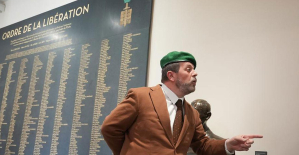The most objective term for Erwin Hagedorn (1952-1972) was "child murderer". Many newspapers called him "beast" or "butcher". Within a few years he had abused and killed three elementary school students in Eberswalde, Brandenburg. His motive: sadism and pedophilia.
The case stands out among the serial murders in GDR times. Not only because of the particular brutality, but because the investigators used unusual methods: the People's Police and State Security publicly searched for the murderer, with posters and newspaper appeals. In addition, for the first time in East German criminal history, a perpetrator profile was created, a so-called profiling.
With success: The 19-year-old Hagedorn was caught - and sentenced to death under East German law, which did not provide for any reduced sentences for adolescents. In 1972, an executioner shot him in the central execution site in Leipzig with an "unexpected" shot in the neck.
With the six-part crime series "Lauchhammer - Tod in der Lausitz" and an accompanying documentary, the German-French cultural broadcaster Arte is dedicated to serial murders committed at various levels in the GDR in September. It becomes clear that the manhunts in the socialist workers' and farmers' state usually proceeded fundamentally differently than in the Hagedorn case. Because in the Marxist-Leninist worldview there was actually no place for abnormal human behavior.
Unlike capitalism, which builds entirely on the individual, in socialism people are seen as a product of the state. Ergo, the state has failed when people go astray. “Lauchhammer” gives an impression of what this way of thinking led to. The acting duo Mišel Matičević and Odine Johne investigate a mysterious murder of a girl in the former Lusatia lignite mining area - and come across other unsolved crimes.
"The crime story is invented. But it's not the circumstances," emphasizes Frauke Hunfeld, who wrote the script together with Silke Zertz. "Certain types of criminal cases were not publicly discussed in the GDR for ideological reasons and were not investigated by normal homicide commissions. After reunification, many files were lost. Many convicts were rehabilitated, not always rightly so.”
The accompanying documentary "Mord, Mord, Sozialismus" also shows how difficult it was for the socialist authorities to deal with the phenomenon of serial murder. The "strangler of Plauen" and the "vampire", who murdered in Polish Upper Silesia, serve as examples. “The state apparatus in the east kept such cases under wraps as well and as long as possible so as not to cause trouble. Information was only provided when it was no longer possible,” says Magdalena Gwóźdź-Pallokat. The German-Polish journalist and film author, who leads through the Arte documentary, came across a frightening connection in the course of her research: her grandfather was briefly considered a suspect in the case of the "Vampire" serial murders - luckily wrongly.
Hans Thiers provides an overview of how the East German investigative practice went in detail in the non-fiction book "Serienmörder der DDR" (2018), with the former officer emphasizing the high clear-up rate and other successes. "The socialist criminology of the GDR did not speak of mass murderers or serial killers, but described this type of crime as focal points," writes Thiers. "Sensational press releases or even the mentioning of perpetrator knowledge by police officers or public prosecutors were alien to the authorities." In his book, he describes a dozen cases of serial murder committed in East Germany, including that of Erwin Hagedorn.
"Serial killers live beyond the social order in our midst. They are our neighbors,” says Thiers. He criticizes the "caricature" that the media and films such as "The Silence of the Lambs" (1991) have established of serial killers. In fact, not every perpetrator is highly intelligent like the cannibal Hannibal Lecter embodied by Anthony Hopkins. However, this does not change the real horror triggered by multiple murderers like Erwin Hagedorn.
"Lauchhammer - Death in Lusatia", September 8 and 16, 2022, 8:15 p.m., Arte
You can also find "World History" on Facebook. We are happy about a like.

 Rishi Sunak wants a tobacco-free UK
Rishi Sunak wants a tobacco-free UK In Africa, the number of millionaires will boom over the next ten years
In Africa, the number of millionaires will boom over the next ten years Iran's attack on Israel: these false, misleading images spreading on social networks
Iran's attack on Israel: these false, misleading images spreading on social networks Iran-Israel: David Cameron wants the G7 to impose “coordinated sanctions” on Iran
Iran-Israel: David Cameron wants the G7 to impose “coordinated sanctions” on Iran New generation mosquito nets prove much more effective against malaria
New generation mosquito nets prove much more effective against malaria Covid-19: everything you need to know about the new vaccination campaign which is starting
Covid-19: everything you need to know about the new vaccination campaign which is starting The best laptops of the moment boast artificial intelligence
The best laptops of the moment boast artificial intelligence Amazon invests 700 million in robotizing its warehouses in Europe
Amazon invests 700 million in robotizing its warehouses in Europe Solar panels: French manufacturer Systovi announces the cessation of its activities due to “Chinese dumping”
Solar panels: French manufacturer Systovi announces the cessation of its activities due to “Chinese dumping” Tesla: canceled in court, Musk's huge compensation plan will again be submitted to shareholders
Tesla: canceled in court, Musk's huge compensation plan will again be submitted to shareholders Two, three or a hundred euros: who are the most generous customers with tips?
Two, three or a hundred euros: who are the most generous customers with tips? Boeing safety examined in US Senate, after whistleblower's revelations
Boeing safety examined in US Senate, after whistleblower's revelations Immersion among the companions of the Liberation
Immersion among the companions of the Liberation Provence-Alpes-Côte d’Azur releases several hundred thousand euros for the promotion of the work of Marcel Pagnol
Provence-Alpes-Côte d’Azur releases several hundred thousand euros for the promotion of the work of Marcel Pagnol A palm of honor distinguishes Studios Ghibli for all of their work
A palm of honor distinguishes Studios Ghibli for all of their work Gaby, a new play by Pagnol adapted into a comic strip
Gaby, a new play by Pagnol adapted into a comic strip Skoda Kodiaq 2024: a 'beast' plug-in hybrid SUV
Skoda Kodiaq 2024: a 'beast' plug-in hybrid SUV Tesla launches a new Model Y with 600 km of autonomy at a "more accessible price"
Tesla launches a new Model Y with 600 km of autonomy at a "more accessible price" The 10 best-selling cars in March 2024 in Spain: sales fall due to Easter
The 10 best-selling cars in March 2024 in Spain: sales fall due to Easter A private jet company buys more than 100 flying cars
A private jet company buys more than 100 flying cars This is how housing prices have changed in Spain in the last decade
This is how housing prices have changed in Spain in the last decade The home mortgage firm drops 10% in January and interest soars to 3.46%
The home mortgage firm drops 10% in January and interest soars to 3.46% The jewel of the Rocío de Nagüeles urbanization: a dream villa in Marbella
The jewel of the Rocío de Nagüeles urbanization: a dream villa in Marbella Rental prices grow by 7.3% in February: where does it go up and where does it go down?
Rental prices grow by 7.3% in February: where does it go up and where does it go down? Europeans: the schedule of debates to follow between now and June 9
Europeans: the schedule of debates to follow between now and June 9 Europeans: “In France, there is a left and there is a right,” assures Bellamy
Europeans: “In France, there is a left and there is a right,” assures Bellamy During the night of the economy, the right points out the budgetary flaws of the macronie
During the night of the economy, the right points out the budgetary flaws of the macronie Europeans: Glucksmann denounces “Emmanuel Macron’s failure” in the face of Bardella’s success
Europeans: Glucksmann denounces “Emmanuel Macron’s failure” in the face of Bardella’s success These French cities that will boycott the World Cup in Qatar
These French cities that will boycott the World Cup in Qatar Union Bordeaux Bègles-Clermont: at what time and on which channel to follow the Top 14 clash?
Union Bordeaux Bègles-Clermont: at what time and on which channel to follow the Top 14 clash? Football: Ada Hegerberg extends at OL until 2027
Football: Ada Hegerberg extends at OL until 2027 Basketball: suspended for life from NBA for fixing his match
Basketball: suspended for life from NBA for fixing his match Paris 2024 Olympic Games: boxer Estelle Mossely wants to parade on the Seine as a flag bearer
Paris 2024 Olympic Games: boxer Estelle Mossely wants to parade on the Seine as a flag bearer


















